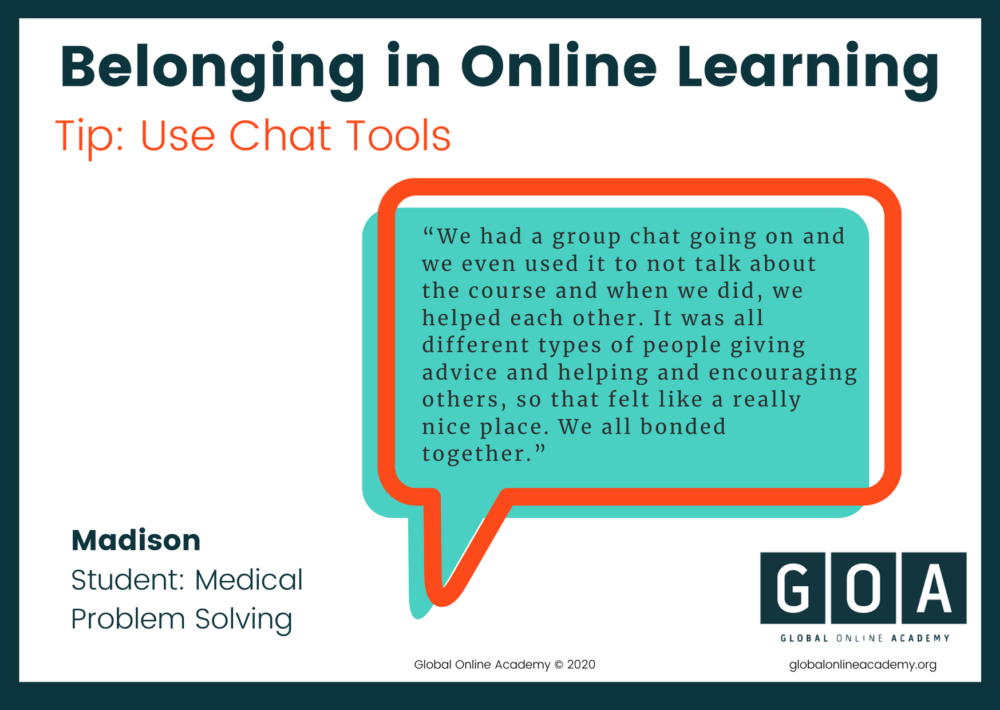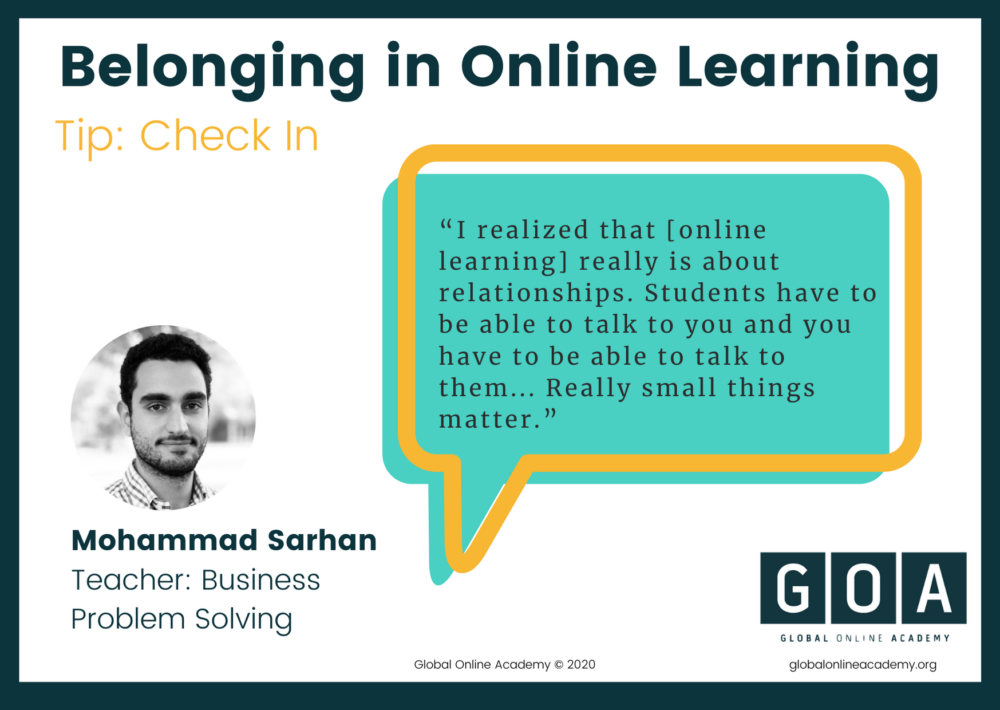How to Cultivate Belonging in Online Learning
“Diversity is having a seat at the table, inclusion is having a voice, and belonging is having that voice be heard.” -@lizandmollie
For students, belonging matters. Meaningful learning occurs when students show up as their whole selves and feel they are valued in their learning space. In “Belonging as a Guiding Principle,” Kelly Allen and Terence Bowles define belonging as “the belief of students that adults within their school community care about their learning, have an interest in them as individuals and have high academic expectations.” Allen and Bowles’ research finds a direct correlation between belonging and student motivation, school completion, emotional and mental health, and physical health in the present and future.
Given that so many schools are now working in online or hybrid formats, how can we nurture a strong sense of belonging in online spaces?
This past summer, GOA summer session brought close to 1,200 students together with over 50 teachers in an online learning community, our largest cohort since our founding in 2011. I embarked on a project to explore how GOA teachers and students created and felt a sense of belonging. To learn more about belonging in online learning, I leaned on the research of Peacock, Cowan, Irvin, and Williams in “An Exploration Into the Importance of a Sense of Belonging for Online Learners” which identified three significant themes: interaction/engagement, culture of learning, and support. With these three themes in mind, I held Zoom conversations with three GOA teachers and three GOA students who shared their experiences of belonging in GOA courses.
Create Spaces and Opportunities for Students to Connect
Ayako Anderson (Noble & Greenough School/Phillips Academy Andover) has been teaching Japanese Language through Culture at GOA since 2012. In online spaces, she said, “there is no hallway talk or lunch conversation at GOA. Everything is intentional.” To design intentionally for connection, Ayako shared two strategies:
Find a Great Chat Tool

Every GOA teacher creates a Twist community where students can communicate with one another in an informal setting beyond discussion posts and emails. It was through this platform that Madison (Latin School of Chicago), a GOA student, was able to create a strong bond with her peers: “We had a group chat going on and we even used it to not talk about the course and when we did, we helped each other. It was all different types of people giving advice and helping and encouraging others, so that felt like a really nice place. We all bonded together.”
The teachers create this space for students; however, students are able to connect without the involvement of the instructor. Ayako said, “They reach out to each other through Twist. I am outside of those conversations, but they are connecting and helping each other.”
Use Icebreakers
Madison said that a catalyst for meaningful interaction in her class came after one of her instructors created an icebreaker activity before a Zoom meeting. Ayako said that she intentionally begins each meeting with such icebreakers in her courses: “I try to choose and mix questions that would highlight their commonality (like after-school activities) and something that would reflect their heritage/local cultures. And something that makes them laugh. Sense of humor and shared laughs are so important!” Screen Breaker and Stoke Deck are just two icebreaker resources that instructors can use for synchronous and asynchronous gatherings to foster belonging.

Reimagine Grading and Assessment to Build a Culture of Learning
Stephen (Providence Day School), a GOA student who took Medical Problem Solving I this summer, said a shift in the traditional teacher/student relationships is the greatest factor in his sense of belonging. He said his initial response to synchronous meetings is to disconnect completely. As he began to process and reflect on what allows him to show up in the conversation, however, he realized he engages when the teacher sheds the role as lecturer and acts more as a partner to students in the learning environment.
Kurt Prescott (Teachers College Columbia University), who teaches Genocide and Human Rights and Applying Philosophy to Global Issues, agrees that teachers can set the tone for belonging. He specifically mentioned creating a culture of learning that breaks down the traditional power dynamic between teachers and students and allows teachers to walk alongside students in their learning process. Kurt said one of the most impactful ways to create this relationship is through equity in grading and assessments: “As I learned more about grading and assessment, I increasingly felt tensions with the system where I say I want them to learn and make mistakes and that I’m invested in doing that with them, yet the way I grade says something very different. Competency-based learning, if fully implemented, can actually do that.”
Kurt described competency-based learning (CBL) as a system where a student’s “mark represents what they’ve learned and not what they knew on day one.” He compared CBL to the way he assessed learning as a track coach: “You have an outcome built on the end of the season, but success isn’t determined by an average of how you do at every meet. It’s not even a declining average. And it’s not even the end of it. Maybe you had two or three meets in there where you were able to meet a particular standard of performance and we know you can do it.”
He believes that CBL allows a more authentic conversation around assessment and thus an increased sense of belonging for students: “You can make a mistake on this earlier assessment, and if you improve over the course of the term, that growth is going to be reflected in the ultimate assessment that goes on your transcript.” Kurt added that CBL will allow a fundamental reframing of the student-teacher relationship by removing the “intrinsic power dynamic” and allowing teachers to be a “co-curator/explorer of student discovery” and not a “gatekeeper” of grades.
Check In, Check Your Tone, and Praise Your Students

Mohammad Sarhan (King’s Academy) taught Business Problem Solving and leaned into the support needed to create a sense of belonging for his students: “I realized that [online learning] really is about relationships. They have to be able to talk to you and you have to be able to talk to them. It doesn’t even have to be crazy conversations. Just checking on someone. Really small things matter.”
During the summer, Mohammad took notes of the conversations that happened with students and scheduled time to check in with students individually, asking questions based upon their last conversation: “How are you doing? How has your summer been? You told me you were going to New York. How was the trip? Last week, you were struggling with the assignment. How is it going since we have a formula due in a couple of days?”
Bassil (Kingswood Oxford School), said that these types of frequent check-ins were one of the main reasons he felt a sense of belonging in his Geometry course: “My teacher was really supportive and really helpful and made me feel like I belonged. He reached out to me when he thought I needed help in the course, and he listened to me and helped me when I really didn’t understand the concept.”
Mohammad agreed that tone matters. In order to foster a safe community of learning, he ensures that any words he uses in both written and spoken communication are always with support in mind. Lastly, he stresses the importance of “shining the light on good work.” Mohammad makes it a point to praise individual work and group work on a regular basis, knowing this will contribute to a strong sense of community and belonging for his students.
Belonging matters. In the online learning space, instructors can foster belonging by creating intentional spaces for students to show up, by reimagining assessments with equity in mind, and by supporting students by checking in and ensuring positivity in tone and feedback. These simple steps are what allowed GOA students from all over the world to come into an online learning environment where their voice was heard and they were valued as individuals.
GOA's Student Program offers high-quality, passion-based online courses for middle and high school students. Member schools have full access to our course catalog, and educators from member schools can take our educator courses for free. To inquire about membership, complete this form. For more free resources on online learning, visit our COVID-19 landing page.
